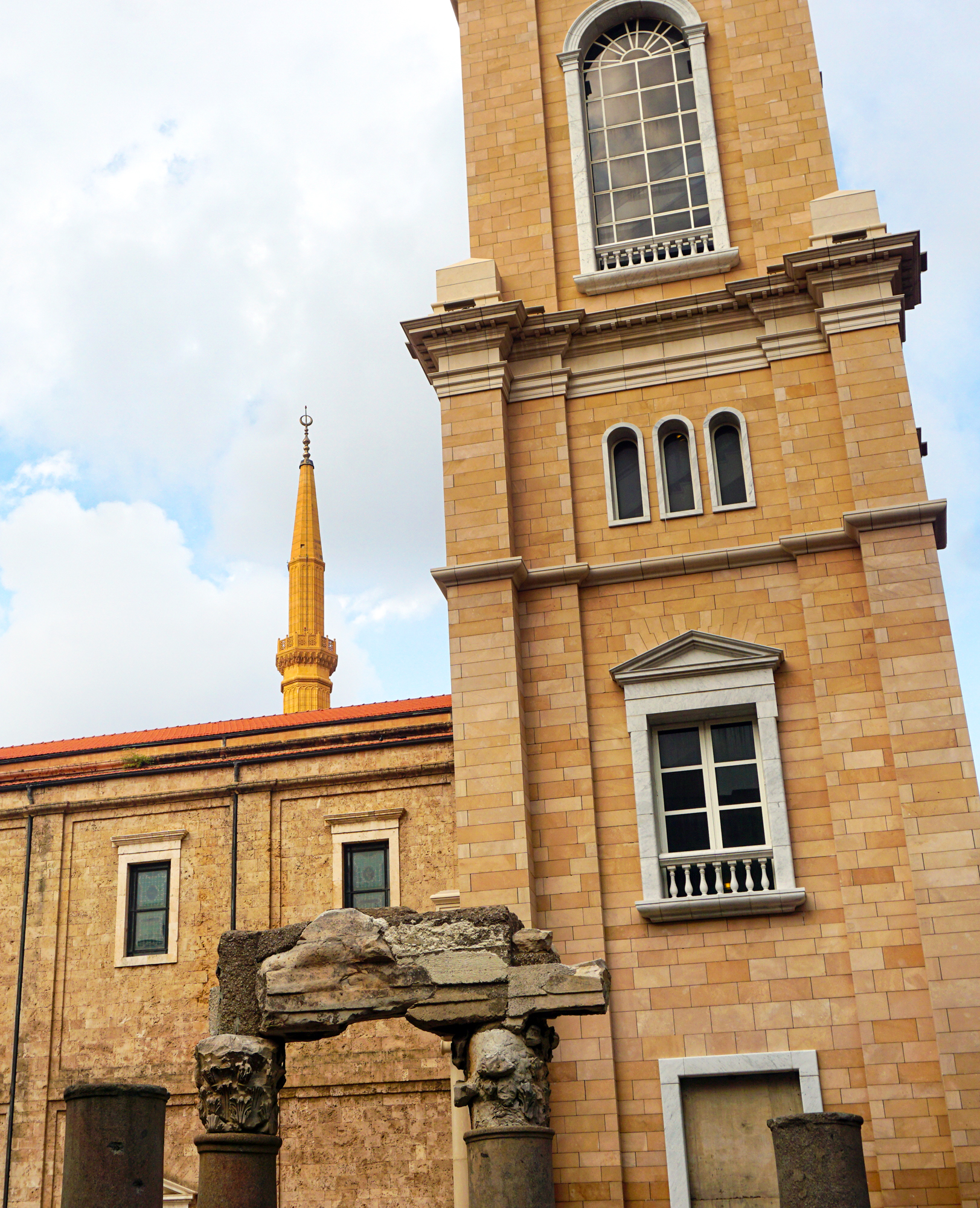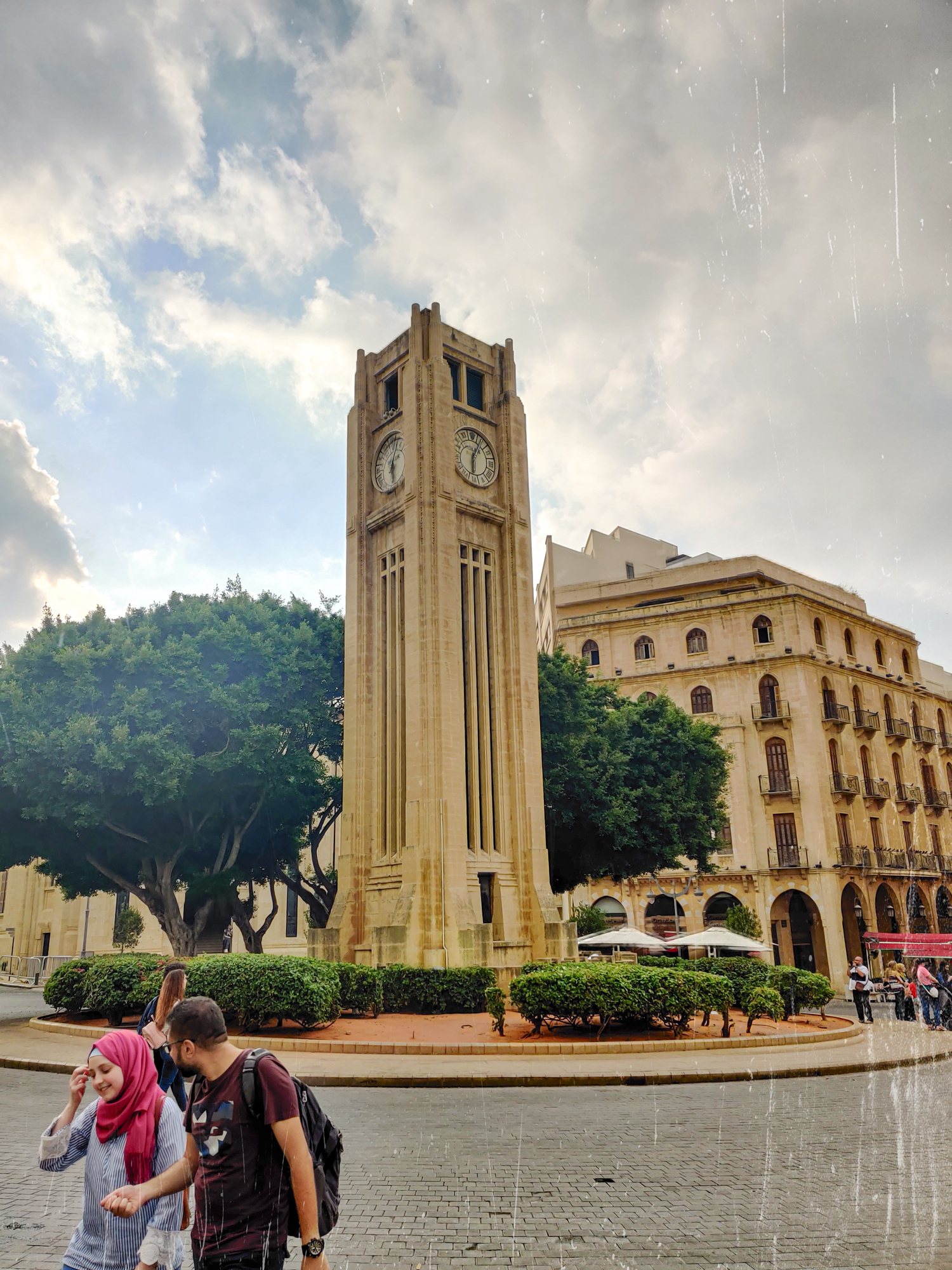TOURING BEIRUT: 7 Sites in 10 Minutes
St. George Maronite Church alongside Mohammad Al-Amin Mosque. Beirut, Lebanon. Photo by Deets on Eats
Dear Foodie Fam,
Read on for a glimpse of the the most diverse city walk I’ve ever taken.
Place Des Martyr / Independence Square. Beirut, Lebanon. Photo by Deets on Eats
7 Must-See Sites in 10 Minutes
Maybe you already know how extremely eclectic Beirut is! If you don’t, read about that on my prior Beirut blog post.
This area - which is less than a square mile large - is a perfect example of how multifaceted Beirut’s history is.
Obviously it would take you more than 10 minutes to take this walk but only because you would want to stop for photos and take it all in!
1 . Place Des Martyr/Independence Square
Place Des Martyr / Independence Square. Beirut, Lebanon. Photo by Deets on Eats
It was once named Artillery Square (place des Canons)… then it became “Martyrs’ Square”… and it is now “Independence Square”.
As the most significant symbol of modern Lebanon, Place Des Martyr/Independence Square is where massive anti-occupation protests occurred in 2005 and the Cedar Revolution was staged in 2007.
In 1965 a bronze statue was raised in the square’s center as a tribute to a group of Lebanese nationalists sentenced to death for rebelling against Turkish rule in 1916. The statue sits on what used to be the Green Line dividing Beirut’s predominantly Christian east and Muslim west during the civil war.
Today, this bullet-ridden statue stands defiantly against all odds, surrounded by buildings new and old - finished and unfinished - of different religious and cultural backgrounds.
Place Des Martyr / Independence Square. Beirut, Lebanon. Photo by Deets on Eats
Place Des Martyr / Independence Square. Beirut, Lebanon. Photo by Deets on Eats
Place Des Martyr / Independence Square. Beirut, Lebanon. Photo by Deets on Eats
Mohammad Al-Amin Mosque. Beirut, Lebanon. Photo by Deets On Eats
2 . Mohammad Al-Amin Mosque
Also known as the Blue Masjid, this mosque became a dominant fixture of the Beirut skyline in 2008. Its blue dome is over 157 feet high and its minarets are over 213 feet high.
The golden colored, soaring figure is inspired by Ottoman architecture, namely that of Istanbul’s Hagia Sofia.
Mohammad Al-Amin Mosque. Beirut, Lebanon. Photo by Deets On Eats
3 . Al-Omari Mosque
Source: Wikipedia
A Roman temple to Jupiter once stood here… When that was destroyed, the foundations were used to support a Byzantine church in 635 AD… which became a Crusader church in the 12th century… which was replaced with this mosque when Mamluks took over in 1291. The building’s triple-apse Romanesque architecture resembles styles used on buildings in Tyre and Tartus.
The mosque was fully renovated in 2004 after Civil War damaged it badly. Beneath the church, an ancient Roman cistern was found and preserved. Even with it’s present day life as a mosque, Ottoman and Greek inscriptions and Romanesque stone live alongside soft red carpet under the same cross-shaped roof. The building houses both a shrine to John the Baptist (enclosed by a golden steel cage gifted by Sultan Abdul Hamid II) and hairs from prophet Muhammad (gifted by Sultan Abd ell mejid I).
Mohammad Al-Amin Mosque. Beirut, Lebanon. Photo by Deets On Eats
4 . St. George Maronite Cathedral
Sitting right beside Mohammad Al-Amin Mosque is this 19th-century neoclassical cathedral and the city’s seat of the Maronite archdiocese. As the Al-Amin mosque was inspired architecturally by Istanbul’s Hagia Sofia, this cathedral was inspired by Rome’s Basilica di Santa Maria Maggiore in Rome.
In the Lebanese civil war, the cathedral was hit hard. It suffered defacement and lost a painting of the cathedral’s patron saint as painted by none other than Delacroix. Not until 2000 was the cathedral restored and re-inaugurated.
Mohammad Al-Amin Mosque. Beirut, Lebanon. Photo by Deets On Eats
Mohammad Al-Amin Mosque. Beirut, Lebanon. Photo by Deets On Eats
Mohammad Al-Amin Mosque. Beirut, Lebanon. Photo by Deets On Eats
4 . Roman baths
These Roman baths were discovered in 1968. Here is where local Romans met in four major bath complexes called “thermae.” Wood fires, terra-cotta disks, marble tiles and water were used to create warm and hot spaces to move through. Romans could get a massage or even watch musical performances.
After it’s cleaning and renovation was completed in 1997, the Baths became a public space. One area of the Baths is used in performances and concerts. There’s also “The Garden of Forgiveness,” a medicinal garden where one could still find plants originally used as Roman bath balms.
Roman Baths. Beirut, Lebanon. (St. George Maronite to right, Greek Orthodox Church of St. George Museum straight ahead). Photo by Deets On Eats
Greek Orthodox Church of St. George Museum (at left). Beirut, Lebanon. Photo by Deets On Eats
5 . Greek Orthodox Cathedral of Saint George
Saint George is Beirut’s oldest living church building. During the Civil War, the cathedral was damaged and defaced. It’s frescoes were left to decay and it’s icons were stolen or set afire. Unlike the ancient and medieval churches which were demolished on the same ground by earthquake, this church stood. The cathedral was restored and opened to the public in 2003.
The ground’s original church (Anastasis cathedral) once bordered the ancient Beirut school of law. In an attempt to triangulate the location of the law school, excavations were undertaken. Artifacts found from the Hellenistic, Roman, Byzantine, Medieval and Ottoman eras are now on display in a museum crypt below the cathedral.
Source: Wikimedia Commons.
Greek Orthodox Church of St. George Museum (at left). Beirut, Lebanon. Photo by Deets On Eats
Source: Wikimedia Commons. Photo by Deets On Eats
Place de l'Etoile / Clock Tower. Nejmeh Square. Beirut, Lebanon. Photo by Deets On Eats
6 . Place de l'Etoile / Clock Tower
Downtown Beirut’s central square, Nejmeh Square is a prime example of Beirut’s urbanization. This is a great place for people watching.
The glamorous, Parisian inspired Rue Maarad empties into this Art Deco inspired square. A four-faced Rolex clock tower built in the 1930s sits at the center, surrounded by pretty cafés, the crypt museum, the Lebanese Parliament, Deputies’ office buildings and other commercial buildings.
Source: Wikimedia Commons.
Place de l'Etoile / Clock Tower. Nejmeh Square. Beirut, Lebanon. Photo by Deets On Eats
Source: Wikimedia Commons. Greek Orthodox Cathedral of Saint George at top left.
Source: Wikimedia Commons
7 . LEBANESE PARLIAMENT BUILDING
The Lebanese Parliament has 128 members that serve five years (extended from four starting in 2018). Half the seats are reserved for Christians per Lebanon’s Constitution.
The Parliament elects the President and approves laws and expenditure.
The Parliament building was designed by the same designer of the Étoile clock tower. It’s design was based on Emirs’ palaces in the Chouf Mountains. Built during French Mandate in 1934, it also incorporates Beaux-Arts design elements.
Dutch enjoying the scene - the Roman Baths, St. George Maronite Church and Mohammad Al-Amin Mosque. Beirut, Lebanon. Photo by Deets On Eats
My Experience
It was a pretty good walk from our place in Mar Mikhaël to Independence Square - lined with varied architecture, trendy cafés, roads under construction, walls peppered with posters, painted murals, urban stairways galore and lots of people out and about.
I was nerve-wracked about walking when we went out, that day. I was still recovering from my stomach bug, so we took it slow in the heat. Thankfully, I adore humidity. Just look at the natural beachey waves it gave my hair!
Dutch photographing the statue at Independence Square. Beirut, Lebanon. Photo by Deets On Eats
Dutch was very sweet about taking it all in stride for me. I still felt really bad that my illness restricted just how much he felt like touring while I was in bed. It was really nice to see his eyes light up and finally get to see him snapping away on his camera. He sometimes told me he was proud of me for sucking it up to walk out to these sites but honestly, why wouldn’t I try the minute I could? I hate to say it but who knows when we would return?
The light hitting the entire area was that of the “golden hour” and everything was ablaze with sentiment.
When we got to Independence Square, the short walk from one site to the next blew my mind. It was brilliant taking all these scenes in. The sites were all so close to each other that it really wasn’t so hard to walk for me. Seeing the buildings all collaged against the sky was thrilling.
My favorite part about this walk is seeing all the people out enjoying the same scenes we were. Being an American from a country freshly minted compared to countries across the ocean, I can’t ever get over people-watching near historic sites. It’s not that the locals are sitting and adoring the same things I am as a tourist… it’s that these sites have melded into the familiar landscape.
To many kids, the Mohammad Al-Amin mosque has become a landmark like the blue-canopied grocery store you know to turn right at when driving home… The Greek Orthodox Cathedral of Saint George is where you meet up with your friends to kick around a ball and harass the local shop owner for free candy…
Life was just going on. Businessmen were on their phones. Families were watching kids chase pigeons. Young lovers were making out in the steeple shadows. Priests scurried past camera-clad tourists blocking their way obliviously. They were all just living their lives amongst the symbols of their history and ancestors.
The Clock Tower was like a grandfather who was always there, silently watching you through the years. You didn’t think about it much but you knew if it were ever gone, a huge part of your identity would be lost, too.
If you are going to Beirut, you couldn’t truly know the heart of this city without seeing these awe-inspiring sites. I really felt something bigger than humanity when taking it all in.
A gate belonging to St. George Maronite Church with minarets belonging to Mohammad Al-Amin Mosque. Beirut, Lebanon. Photo by Deets On Eats






























